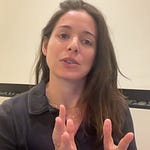Product people often find themselves juggling various unowned tasks that just seem to land in our laps. That’s the definition of product, right 🫠 Working with a client this week, I remembered all the times I took on all the problems because I was ambitious, maybe a bit people-pleasing, and felt like it was better to say yes and prove myself. Even if that meant teetering on the edge of burnout.
Specifically, PMs are often the ones pointing out that shared resources - like user research or data science - are in need of support. It’s usually because ambitious PMs need those resources to service an existing project.
So…what do you do when a shared resource problem falls in your lap. Do you…
say yes and bite off more than you can chew, opening yourself up to scope creep and boundary pushing
say no and hope someone else will take on the problem or go without the resource you need
My advice: say it’s a choice
The key to navigating this type of chaos is not to simply accept or reject the work outright, but to frame it as a choice with explicit dependencies. Lay out the options and clearly communicate the impact of each choice. Then let the decision-makers take ownership of those trade-offs.
Frame it as choice
When I found myself in a similar situation, being asked to take on more than I could handle, I found rather than saying yes or no, it as better to lay it out as a decision that had tradeoffs.
Tactically I was covering Project A, B, C and D. So I presented the facts:
“If I’m working across Project A, B, C and D, I’m only able to give 20% of my attention to each. As a result, we’ll move each along at a slower pace.”
“If I’m working across Project A and C, I can give 50% of my attention. And as a result, we’ll likely drive more meaningful outcomes for the product.”
Then I’d lead with a proposal:
“I think I should start with Project A and C since they are more directly tied to our OKRs. I also believe that learnings from Project C will determine if we even need to proceed with Project D.”
The key here is to demonstrate what’s to be gained and lost with the lack of focus. And further, presenting this as a tradeoff decision to leadership empowers the leader to be in the drivers seat.
Note: If you have a manager that insists on covering it all, the key is to double down and get familiar with not only your inefficiencies, but the inefficiencies of this choice for your entire team. A team moving 5 projects along at 20% isn’t going to sustain and won’t hold up in OKR court. Make sure you can quantify that impact.
The Importance of Boundaries
Once the decision is made, it's crucial to set clear boundaries. It’s not enough to just say, “I won’t work on X right now.” You need to establish what you will and won’t do — and communicate that.
I recommend a few things:
Crystalizing the tradeoff discussion in an artifact including a timeline
Socializing that artifact - effectively
Revisiting that artifact over time - again and again
This not only shields you from overextending yourself but also ensures there’s alignment. When questions arise, your leader can back you up because you’ve already agreed on where your focus should be.
It’s All Temporary
Most choices aren’t permanent. When you agree to focus on certain tasks and deprioritize others, it’s for this moment in time.
Product work is fluid, and so are our priorities.
What you’re choosing not to do today might come back into focus tomorrow.
Or… you might realize that priorities just fall off the list all together. 👇
Hi - I’m Jori and I’m a Product Coach. Here’s how to work with me ↩️
I work with Product Leaders and their teams to unlock their biggest career moments. If you’re looking for support - drop me a note, I’d love to connect. 🤝
I co-host Product Leadership Breakfast NYC, a monthly product breakfast series to bring together curated groups of PM leaders to connect and share learnings and insights over casual breakfast. If you live in NYC or find yourself passing through, join us! ☕











